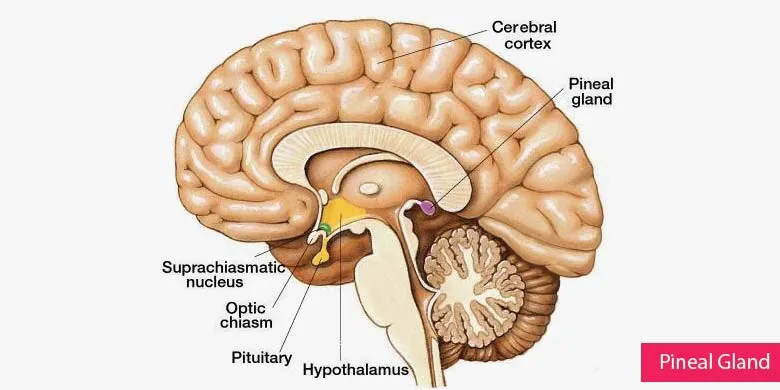What Is Pineal Gland? Pineal Gland Function in the Human Body
- What are the other terms used to refer to the pineal gland?
- Why do you call it “pineal”?
- How does your body regulate the 24-hour cycle of biological activities?
- Is it light or darkness that stimulates the production of melatonin?

During the 24-hour period, you sleep for about 8 hours and remain active for the remaining 16 hours. While you are asleep, your body either slows down or totally shuts down certain systems or activities.
For example, the blood pressure, the temperature of your body, heartbeat rate, the speed of breathing, and metabolic activities decrease during sleep.
The voluntary activities of muscles almost disappear during the resting period.
The nerve organs which stimulate the voluntary muscles also go to sleep. The semi-voluntary and involuntary muscles and their nerves, however, merely go to sleep.
Similarly, there occur changes in the activity of the digestive system.
Interestingly, your digestive system starts working more vigorously while you rest!
On the other hand, your body experiences vigorous physical and mental activities during the wakeful hours. Also, there is an increase in the growth of tissue cell.
Now the question is: “How does all this happen?” Put in other words, “How does your body regulate the 24-hour cycle of biological activities in relation to the natural periods of darkness and light?”
Learning about “What is pineal gland function?” will help you understand the mystery.
What Is Pineal Gland?
The pineal gland is just one component of a wide network of hormone-secreting organs in your body. It is known by several different names such as the pineal organ, pineal body, conarium, and epiphysis cerebri.
Located between the left and right hemispheres of your brain and behind the 3rd cerebral ventricle, the gland has long been an enigmatic structure for the scientists.
Even after stepping into the 21st century, the researchers were unable to completely understand the extent of the effects of melatonin, which is the principal hormone secreted by this organ.
Do you know why was the pineal gland named so? The name of the gland has been derived from its shape. Itresembles a pinecone, which is translated as “pinea” in Latin.
Regarding its size and shape, the organ measures less than one centimetre (about 0.8cm) and weighs as low as about 0.1 g!
Endocrine or Exocrine:
The hormone-secreting organs in your body have been put under two categories, endocrine and exocrine. You would call it an exocrine gland if it releases its secretions (hormones) into cavities inside your body or its outer surface.
On the other hand, an endocrine gland is the one that empties its products into the bloodstream.
The pineal gland belongs to the latter category, i.e. it is an endocrine gland.
Pineal Gland Function:
The most important pineal gland function is its role in the regulation of circadian rhythm. Circadian rhythm refers to the cyclical repetition of various biological activities in your body after every 24 hours.
Regarding how the gland contributes to the regulation of this rhythm, it does so through the secretion of melatonin hormone.
The secretion of melatonin hormone is influenced by the periods of light and darkness, which are detected by the retina of the eye.
The pineal gland starts producing the hormone in the absence of light. On the contrary, the detection of light by the retina leads to its inhibition.
Its secretion promotes sleep by creating the temperature of your body and the respiration rate, etc.


